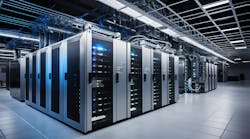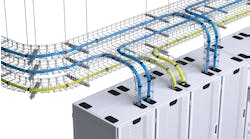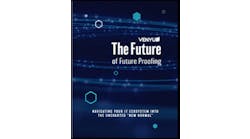Making Your Data Center Water Positive
Cem Candir, CEO of Chemstar WATER, provides insights on new innovations in data center water treatment and gives details on how some hyperscalers are making their data centers water positive.
Cem Candir, CEO of Chemstar WATER
Let’s face it. Our unprecedented demand for data has created an unprecedented demand for more data centers. Of the resources required to develop and run a data center, one resource is vital: Water.
Why water? Data centers use a tremendous amount of electricity—the largest use enough electricity to power 80,000 households. The abundance of power creates an abundance of heat, which can impact data center equipment, potentially leading to costly breakdowns.
According to recent research, inefficient cooling technologies can account for up to 40% of data center energy. At once ubiquitous and inexpensive, water presents an ideal solution to data center cooling.
You may remember from high school chemistry: Water molecules are drawn together by hydrogen bonds, creating relatively high surface tension. To phase change, water must absorb a large amount of energy. In other words, when evaporated, water draws energy, cooling the surrounding air better than any other feasible media.
Simply put, water is the most efficient cooling medium. No wonder water is the primary cooling choice for data centers worldwide.
To be sure, the industry does use other non-water-cooling technologies, from basic fans to complex heat transfer technologies like hot aisle containment. New liquid immersion technologies even bathe the equipment in cool liquids (not water). However, no technology has yet to match the efficiency and price tag of water-cooled systems.
Water is a precious and finite resource critical to every entity on this planet. In recent years, water is also increasingly difficult to obtain. Water scarcity is an issue on every continent, and the challenge is only expected to grow. According to the United Nations, over 2 billion people live in water-stressed countries, and the organization projects global water demand will outstrip supply by 40% by 2030.
We are fortunate to see significant initiatives already taken by data industry leaders and hyperscalers. Recently, Microsoft announced an ambitious plan to replenish more water than it consumes by 2030. Microsoft is also currently funding a wastewater treatment plant in Quincy, WA, to re-use wastewater instead of tapping into the local potable water resources.
Amazon Web Services (AWS) has similarly pledged to work towards a sustainable water future. An AWS data center in Northern Virginia was the first to use recycled water with direct evaporative technology. AWS is now retrofitting data centers in Northern California to use recycled water. As AWS notes:
When evaluating cooling technologies, we assess water and energy usage to identify the most efficient method and minimize environmental and community impact. We maximize the use of free-air cooling systems that cool servers with outside air without using any water. During peak summer temperatures, we utilize direct evaporative cooling, which uses water to cool the air that removes heat from our servers. Our evaporative units are optimized to use minimal water, and this approach also increases energy efficiency.
Google Cloud has been carbon net-zero since 2007 and is continuously improving its environmental footprint. Innovating new cooling methods, Google Cloud uses extensive seawater, reclaimed water, stormwater, rainwater harvesting, and industrial canal water to reduce its water footprint. And recently, Aligned Energy, a data center infrastructure company, implemented a soft water program in their Phoenix, AZ, facility resulting in 24 million gallons of water savings.
“I understand the profound importance of water. Our most precious natural resource, water, makes the world run. However, in my twenty years of water industry experience, I have learned a vitally important lesson: Water is local.” – Cem Candir, CEO of Chemstar WATER
Despite the worldwide implications, water scarcity and other water-related challenges are always a local phenomenon. It is not feasible to pipe water from water-rich Minnesota to water-challenged Arizona. Today’s data center operators must tackle the water problems on a county-specific or state-specific level starting at the design stage. Broad brush water solutions post construction do not work effectively.
Happily, from the water industry’s perspective, I see a bright future of possible solutions. To mitigate the stress on our limited local water resources, we hope to see more water re-use and conservation initiatives in the future, and we hope to partner with data center operators in the endless pursuit and optimization of water usage.
New water technologies promise to alleviate virtually every water-related challenge a data center may come across. The key to change is a clear focus on efficiency and sustainability. Working together, we can build a water-positive future for the data center industry and beyond.
This article was written by Cem Candir, CEO of Chemstar WATER. He’s a great resource for those interested in better Water Treatment and Sustainability. Connect with Cem on Linked In. As a water company supporting the data center industry, Chemstar WATER is tirelessly researching new ways to provide innovative technologies and viable solutions to support data center operators’ efforts. Learn more at Chemstar WATER.





